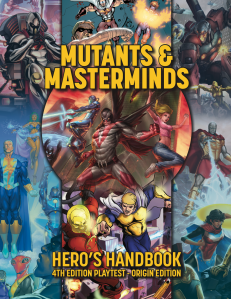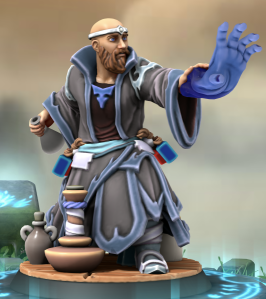Tabletop Tuesday — Origin Edition Hero’s Handbook
As is likely obvious if you’ve been around this here blog (or my social media) for any amount of time, I’m a big fan of Mutants & Masterminds. Now, I came to it late—I only climbed aboard at the 3rd Edition—but as of this month, there’s a new edition in town (or, well, it’s coming), and I have a copy of the Origin Edition release for the playtest, and… unsurprisingly?
I love it.
What Do You Get?The Origin Edition Hero’s Handbook is a 240-odd page playtest version of the 4th edition rules, and honestly it’s the prettiest playtest I’ve ever had access to.
 It’s so pretty.
It’s so pretty.After an introduction, you’ve got The Basics. This covers the thematic and narrative elements of the superhero genre as a game; breaks down the notion of “ranks” as the main measurement of pretty much everything in M&M; offers up the core mechanic of the game. That mechanic is the “check.” Generally, most things in M&M come down to a roll of a d20, adding any applicable modifiers or penalties, comparing the final number rolled to the Difficulty Class (DC), and hoping you beat it. For a great many checks in M&M, that’s it.
Sometimes, however, you need to know how well you succeeded. For this kind of check, there are also “degrees” of success or failure in M&M—a neat mechanic whereby your success becomes more successful when you beat a DC by 5, 10, 15, and so on, and the reverse being true when you fail by 5, 10, 15, etc. These “degrees of success” or “degrees of failure” hold hands with rolling natural 20s and 1s as well—called Added Successes or Added Failures—where after you do the math and see how well you did (or didn’t do), you then nudge it up one level of success (for a 20) or down one level of failure (for a 1) and this means those 20s and 1s can turn “almost made it!” into a success, or “just made it!” into a failure.
You also learn about Hero Points here, which is kind of your “I’m going all in!” character resource during a game—allowing you re-rolls or other unique uses of your character’s abilities so your character can really shine when you need them to do so.
I Need a HeroIn Hero Creation you get the shorthand of getting right to the table: a walkthrough of archetype heroes, each with a few choices to make for you to customize said heroes, and I’ve talked about how even the same archetype can be utilized to very different and enjoyable thematic effects before, but as an entry point to getting people around the table and playing, I can’t suggest the archetypes highly enough. There are fifteen archetypes included in the Origin Edition playtest, though five of the archetypes (Metamorph, Mystic, Primal, and Speedster) offer two or three major “sub-types” thereof, functionally offering even more choice, even before a player tweaks their chosen hero, so in a way, it’s more like twenty-two.
There’s still more than enough customization to be done—including the all-important choosing of your hero’s Motivation(s) and other Complications, which is one of the main tools in the game master’s box in crafting narrative moments specifically for the heroes in question—and can also be a way you earn more of those Hero Points.
If you do want to start from the ground up, the chapter also outlines the Power Point system, which is basically the currency you use to build every single part of a character from scratch at various points-per-ranks expenditures, and one of my favourite things about Mutants & Masterminds is the notion of the Power Level—an overall limit to just how strong certain combinations of powers, abilities, skill rolls, and the rest can possibly be, to denote an overall level of danger that keeps the players (and plots) all within the same general bracket while still allowing them a huge amount of leeway in designing the character they want to play.
Power Points are also how you improve, earning and spending them with the same rules as character creation as the game moves on.
The chapters on Abilities breaks down said scores: Strength, Stamina, Agility, Intellect, Awareness and Presence; and also gives a quick chart to roughly explain how “0” is your average human, and then how each rank compares from there (with 5 being the best in a nation—think an Olympian—and 7 being the pinnacle of what a non-powered, regular-type human might attain).
iThis chapter also introduces “new” Abilities to 4e: the Combat Abilities: Attack and Defense, and also tucking in Initiative as one of the Combat Abilities as well. Fans of 3e M&M will notice the lack of Dexterity and Fighting, and if you’re anything like me, once you read through this section, you’ll cheer at the changes, which are quite streamlined and feel much easier to explain to a new player than the difference between Agility and Dexterity (which my brain could never hold onto).
Basically having a singular Attack as a Combat Ability stands in for the absolute catch-all of fighting, but it costs 2 Power Points per rank, just like all the other Abilities, making it the most expensive way to gain each +1 on an attack roll—later, you’ll have options for adjusting all of your close-range attacks (ie: melee) or all of your ranged attacks, and then even more options for adjusting your attacks with specific powers or weapons—and each layer of specificity comes cheaper than that flat 2 Power Points per rank. Similarly, your Defense will apply to everyone taking any sort of shot at you, and you’ll have ways of making it more effective against certain types of incoming attack later via Skills, Advantages, or Powers.
The short version, though, is I really appreciated seeing this particular bit of streamlining from 3e to 4e—it felt like a natural improvement, the balance feels solid, and did I mention I could never remember the difference between Agility and Dexterity?
Resistances are also covered in Abilities, and your hero will have four of them: Dodge, Fortitude, Toughness, and Will. Dodge is getting out of the way of things you might be able to avoid; Fortitude is resisting things like poison, disease, or other things you might resist via your health; Toughness is more basic durability such as how you handle taking physical damage like a punch; and Will handles all the things that bypass the physical and go straight to your brain or mental endurance. These are where those “degrees” of success or failure often come into play, where you’re trying to shrug off as much of an effect that has already landed on you as possible. You’re in the explosion, but how well did you take cover? The psychic has managed to get into your brain, but how much of her influence can you resist? That powerhouse just landed an uppercut that launched you off your feet, but are you down for the count, or still swinging? And so on.
Next comes Characteristics, which includes size, movement speeds, a discussion of senses and how they work in M&M 4e, and most of this will feel familiar—and I really appreciated the very straightforward breakdown of all the qualities inherent to typical human senses. Size, I believe, also got some clever tweaking, especially in how it relates to characters with growth or shrinking powers.
Skills are next, and there’s a lovely tweak or two here, too. Most of the skills are exactly as you’d expect, such as Athletics, and cost 1 Power Point per 2 ranks (and you can split those ranks over multiple Skills). Other Skills require you to pick a Focus when you take them—such as the Close Combat Skill, where you need to choose what that training applies to: say, one of your Power Arrays, or Blades, or Unarmed.
But beyond the notion of a Focus, there’s also the option to use Specializations now. Specializations are narrower focuses that exist within a more general skill, and gain 4 ranks per Power Point (and, again, you can split those ranks over multiple Skill specializations). So, while I could represent my hero’s love of swimming with 2 Power Points in Athletics and gain 4 ranks of Athletics, I could also be clear that he is a swimmer, not a general athlete, and those same 2 Power Points could give him 8 ranks specifically when he’s using his Athletics check for swimming—but no other use of Athletics. Similarly, in the above Close Combat example, 2 Power Points would give my hero 4 ranks in Close Combat (Blades), but I could instead decide to go the specialization route and those same 2 Power Points could give him 8 ranks in Close Combat (Dagger). You could also split the difference: applying 1 Power Point to Close Combat (Blades), and 1 Power Point to Close Combat (Dagger) would create the sense that your character has trained in swordplay, yes—that’s the +2 with any bladed weapon—but when he uses a dagger, that would jump by another +4, and show off how much extra time he’s spent specifically working with daggers in particular. But, again, you don’t have to get this fiddly if you don’t want to. If you just want to make a character who’s good at fighting, no matter what he’s using, you sink those Power Points into your Attack Combat ability (or in Advantages, which come next).
Advantages are very familiar from 3e (some are Ranked in that you can have levels of them, some you simply have or don’t have), but the 4e tweaking here includes breaking them down into types named after the general type of benefit they provide: Combat, Command, Fortune, General, Heroic, Reaction and Skill. Combat and Skill are exactly what you’d think: they add benefits or bonuses in combat or with skills sometimes letting you use skills in new ways. Command Advantages let you lead or direct others in interesting ways. Fortune Advantages are all about Hero Points (your “I’m going all-in!” currency in Mutants & Masterminds, most often used for re-rolls but there are more options here), Reaction Advantages specifically utilize your reaction, broadening the things you can do in response to outside effects (or enemy actions), Heroic Advantages are a very cool category that are specifically limited by Power Level and give the characters options above-and-beyond what they might normally manage otherwise (such as editing a scene to their advantage, or shrugging off a truly bad roll), leaving General as a catch-all for everything that didn’t fit in one of the other categories.
Advantages are where things like grappling, tripping, and disarming happen, as well as breaking down Attack and Defense Combat Abilities into Ranged or Close at a 1-for-1 Power Point cost (a mid-way cost between a Skill and the full Ability itself), and so many more options it can be really overwhelming to try and pick and choose them when you’re first starting out, but—again—this is why I’m all about using the Archetypes for new players. For 3e fans, the Improved Effect Advantage has taken on the heavy lifting of covering both magical and technological creations (either on the fly or prepared ahead of time), and it’s a much smoother process.
“I want to throw a grenade made of gravy so good people have to stop and eat it!” “Okay.” Kevin’s character, “Pestle.”
Kevin’s character, “Pestle.”Powers come next, and is a massive chapter denoting all the various powers of Mutants & Masterminds, how much a rank of each power costs, and typical ways those powers can be tweaked or used with various extras and flaws. The sheer flexibility of Powers in Mutants & Masterminds was always its strength, but you can feel how streamlined and consistent the 4e offering is—I love building characters for M&M, but even my first time through the 4e process I felt the difference here. A lot of it comes down to how powers have been broken down into specific starting points: Damage, say, for the most obvious “this power deals damage” but then how clearly example options are then laid out: Blast (Damage, Ranged), Mental Blast (Damage, Perception Ranged, Resisted by Will), or a Weapon (Damage, Strength-based, Removable). The parentheticals can seem overwhelming at first, but the consistency is there, and after a trip or two through the journey of character creation, it tends to gel fairly quickly. It all just flows nicely, with the formatting and layout further lending itself to ease of comprehension.
And—because I need to say it again—you can make anything. I’ve yet to bump into a player’s concept for a power they want that I didn’t manage to put together with the M&M rules. It’s that flexible. Seriously, one of the people I play with, Keven Hearne (yes, that Kevin Hearne) wanted to create a Quebecois mystic hero who specializes in making potions who throws “gravygasms.” That would be gravy bombs that make people drop everything to stop and eat the gravy they just got spattered with. I went to the rule book and… well, really, that’s a Sphere Area Affliction, Resisted by Will… Okay. Done.
After Powers comes Equipment, though there’s quite a bit of overlap (after all, a Grenade is really just an object that does Sphere Area Damage) and which some of it is about providing players and game masters a menu of commonly offered equipment, it also covers things like Installations and Vehicles. I really liked how M&M 3e handled coming up with player headquarters, and Installations really does this justice, complete with ready-made examples to pick and choose from.
“I’m Dazed and I’ve taken three hits, but I’m willing to risk it!”Action and Adventure rounds out the chapters with the meat of playing the game—everything from scenes (broken down by some archetypal greats) to rounds (when things shift to combat mode). I really like how a character’s options for a round is now broken down: one standard action (something complex they need to focus on), one simple action (the “doesn’t need a lot of thought” action, such as moving), as well as free actions (yelling “Look out!” to someone, or hitting a light-switch, or dropping something, or any other number of things that are incidental at best). You also get one reaction per round, which happens in response to something or someone else, and doesn’t happen on your turn—and those Reaction Advantages are great for this.
This chapter also goes over how fighting works in M&M, and it’s often one of the stumbling blocks when I introduce new players to the game. There’s nothing like hit points in M&M. Instead, when you get hit (someone makes a successful attack against your Defense Class) you then make a resistance check (most commonly it’s a Damage effect, which you resist with your Toughness) to see how hard that blow landed. If you succeed, you get a “Hit” condition (which is basically an “owie!” that gives you a -1 on further resistance checks against damage), but if you really blow it—say three degrees of failure—it’s possible to be out in one punch, as you’ll get a “Hit” condition as well as the “Staggered” and “Incapacitated” condition. Functionally, even when you roll well, those “Hit” conditions start to stack up, and soon you’re rolling with enough of a penalty that the next hit could be the one that takes you out, which represents the back-and-forth trading of blows really, really well, without the meta-game surety of “well, I’ve got fifteen hit points left, and the worst she seems to be able to dish out is eight points of damage, so I’m good for another round.”
This area is another spot where the streamlining and adjustments from 3e to 4e are visible: the explanations of how people who have specific kinds of invulnerability-based powers react to various Damage effects is clearly laid out (they might not even suffer a “hit” if they have enough degrees of success). Similarly, recovering from various Conditions is also clearly laid out, with examples (alongside how people with Regeneration or Healing powers affect said recovery).
Basically, Conditions are where it’s at from the point of view of the heroes and villains smacking each other around in Mutants & Masterminds, and while they can be a lot to digest your first time out—I use cue-cards, physically handing out the various conditions to players as they’re affected—once you get the hang of them, they’re really great at setting the tone. And hey, narratively they’re a gold mine for the players and game master alike.
I’ve no doubt I’ll be talking more about Mutants & Masterminds here as the playtests continue, but if you’ve got the third edition under your belt and are looking at the Fourth Edition and wondering, I’d suggest making the leap. The streamlining is there (Advantages, Powers, Conditions), as are all the little quality of life adjustments (goodbye Dexterity and Fighting, hello Attack and Defense), and I don’t think I bumped into a single moment where I frowned and thought, I liked it better the other way. I don’t think that’s ever happened before with a new edition.
If you’ve never tried Mutants & Masterminds before? This is a great time to hop on board. And while we’re still waiting for the Masterminds Manual, you can absolutely use the Hero’s Handbook here to put together a quick try-it-out session, as one of the best parts about those Archetypes?
The game master can use them for the villains, too.



